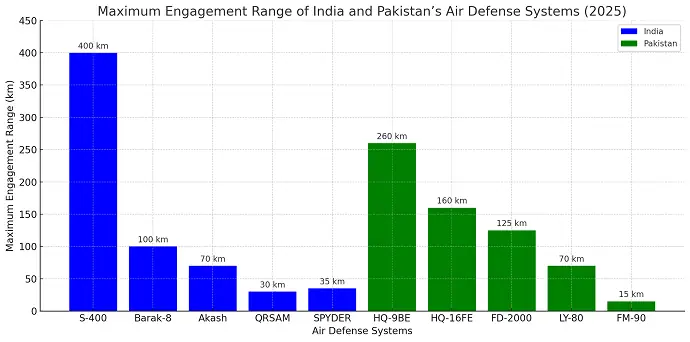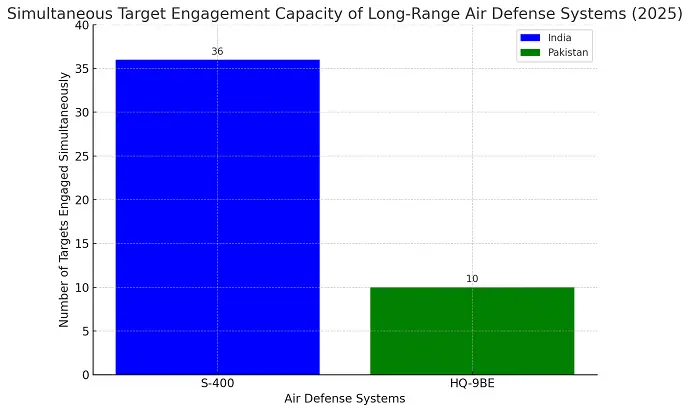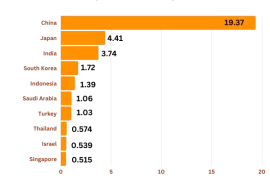India and Pakistan, as nuclear-armed neighbors with a history of conflict, maintain robust air defense systems to safeguard their airspace against aerial threats. This analysis makes a comparison of India and Pakistan’s air defense systems, focusing on key components, capabilities, and strategic implications.
System Overview and Components
India’s Air Defense Capabilities
India’s Air Defense System is characterized by a multi-layered architecture, designed to counter threats from fighter jets to ballistic missiles. The cornerstone is the S-400 Triumf, a long-range SAM system from Russia, with a detection range of 600 km and engagement range of 400 km. It can track nearly 100 targets and engage 36 simultaneously, using missiles like the 40N6 (400 km) and 48N6E3 (250 km). Deployed along borders with China and Pakistan, it enhances defense capabilities significantly.

Complementing the S-400 are medium-range systems like the Barak-8, jointly developed with Israel, with a 70-100 km range, effective against cruise missiles and aircraft. The indigenous Akash missile system, with a 30-70 km range, provides coverage along the Line of Control (LoC), with 8 IAF squadrons and 2 Army regiments (2 more ordered). For shorter ranges, India employs the SPYDER system (15-35 km) and QRSAM (25-30 km), offering flexibility against low-flying threats. India’s radar network includes AESA radars like the EL/M-2084 (Barak-8) and Rajendra III (Akash), providing 360-degree coverage and superior tracking. The Ballistic Missile Defence (BMD) program, with Prithvi Air Defense (PAD) (exo-atmospheric, 80 km altitude, Mach 5) and Advanced Air Defense (AAD) (endo-atmospheric, 30 km altitude, Mach 4.5), intercepts missiles up to 5,000 km away.
Pakistan’s Air Defense Capabilities
Pakistan’s Air Defense System, bolstered by its alliance with China, focuses on protecting key cities like Karachi and Rawalpindi. The primary long-range system is the HQ-9, with variants like HQ-9P (125 km range) and HQ-9BE (260 km range, Mach 14, 25 km vs. ballistic). It can track up to 100 targets but engage only 8-10 simultaneously, less than India’s S-400. Other systems include the FD-2000 (125 km range against aircraft, 25 km vs. cruise missiles), HQ-16FE (160 km range, 27 km altitude, based on Russian Buk), LY-80 (40-70 km, Mach 2.5), and FM-90 (15 km, Mach 1.2). Radar systems like the HT-233 (HQ-9) and JSG-400/JPG-600 (HQ-9BE) are advanced but lack AESA technology’s capabilities.
Detailed Comparison of India and Pakistan’s Air Defense Systems
A comparative analysis of India and Pakistan’s Air Defense Systems
Aspect | India | Pakistan | Notes |
|---|---|---|---|
Key Systems | S-400 (400 km, tracks 100, engages 36), Barak-8 (70-100 km), Akash (30-70 km), QRSAM (25-30 km), SPYDER (15-35 km) | HQ-9BE (260 km, engages 8-10), FD-2000 (125 km), HQ-16FE (160 km), LY-80 (40-70 km), FM-90 (15 km) | India’s S-400 outranges and out-engages Pakistan’s systems; layered defense vs. focused coverage. |
Range and Coverage | Detection 600 km (S-400), engagement up to 400 km, overlapping layers | Longest range 260 km (HQ-9BE), gaps in deep-strike protection | India’s coverage suits two-front scenario; Pakistan vulnerable to standoff weapons. |
Target Engagement Capacity | S-400 engages 36, others like QRSAM enhance flexibility | HQ-9 engages 8-10, limited capacity against saturation attacks | India better equipped for multi-vector threats. |
Radar Technology | AESA radars (EL/M-2084, Rajendra III), 360° coverage | Phased-array (HT-233, JSG-400), less advanced, limited ECM resistance | India’s AESA provides better detection and jamming resistance. |
Anti-Ballistic Capability | S-400 effective, BMD program (PAD, AAD) intercepts up to 5,000 km | HQ-9BE limited (25 km vs. ballistic), FD-2000 less effective | India has significant edge in ballistic missile defense. |
Operational Experience | S-400 combat-proven, 80% success in July 2024 exercise | Systems untested in real combat, effectiveness uncertain | India’s experience gives strategic advantage. |
Comparison of the Maximum Engagement Range of India and Pakistan’s Air Defense Systems

Comparison of the Simultaneous target engagement capacity of India and Pakistan’s Air Defense Systems

Research suggests India’s system is more advanced, with the S-400 offering superior range and engagement capacity. It seems likely Pakistan’s reliance on Chinese technology, while cost-effective, limits its ability to match India’s capabilities, especially against high-speed threats like BrahMos (Mach 3+). The evidence leans toward India having better radar technology and anti-ballistic missile capabilities, with ongoing debate about operational effectiveness, particularly for Pakistan’s untested systems.
Strategic Implications and Challenges
India’s layered defense suits its two-front scenario (Pakistan and China), with the S-400 acting as a force multiplier. However, reliance on Russian technology, like the S-400, exposes India to geopolitical risks, such as U.S. sanctions under CAATSA. India is pursuing indigenous development, with projects like Akash-NG (70-80 km range) and QRSAM, aiming to reduce import dependence.
Pakistan, heavily dependent on China, benefits from cost-effective solutions but faces technological stagnation risks. Systems like LY-80 and FM-90 may struggle against India’s faster standoff weapons (e.g., Rafale-Meteor, 150+ km range, Mach 4.5). Indigenous efforts like LoMADS and FAAZ-SL are in early stages, potentially reducing reliance on imports in the future.
Future prospects include India acquiring additional S-400 regiments or developing long-range SAMs, while Pakistan might upgrade HQ-9 variants or seek new systems from China. The debate continues on effectiveness in real conflicts, with India’s combat-proven systems likely holding an edge.
Conclusion
In conclusion, India’s air defense system, led by the S-400 and supported by indigenous and imported systems, provides a more robust and layered defense compared to Pakistan’s Chinese-sourced systems. India’s superior range, engagement capacity, radar technology, and operational experience give it a clear advantage, but both nations face challenges in modernization. The ongoing rivalry underscores the importance of air defense in their strategic planning, with implications for regional security.







